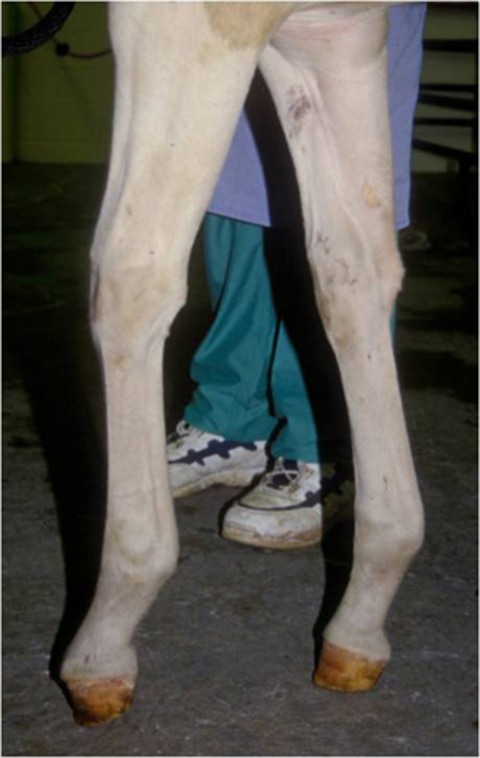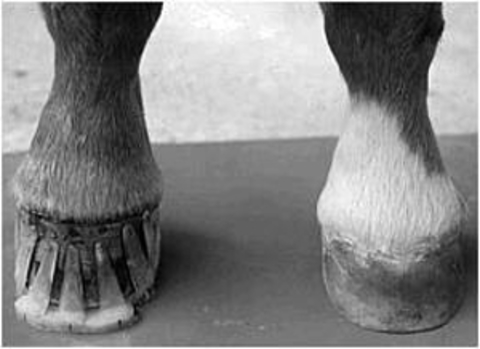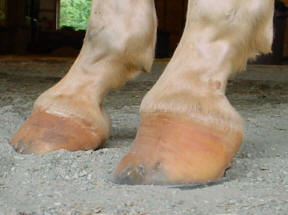club foot horse cause
Type 1 means that the hoof to ground angle at the front of the hoof is greater than 60 degrees but less than or. Causes of club foot Club foot has several possible causes.

How D That Happen Origins And Remedies For Clubfoot Horse Racing News Paulick Report
There are varying degrees of club foot.

. The primary one is genetics. March 17th Thurs. Of club foot A horse with club foot has one hoof that grows more upright than the other.
Foaling trauma foal grazing stance overly fast growth of limbs injury or. The term clubfoot gets thrown around a lot when describing the way a horse particularly a sale prospect looks. Compressing the foot with hoof testers causes pain.
Bandaging can also cause the soft tissue in the affected limb to relax. Club foot is a term commonly used to describe an abnormally upright front foot conformation. The top of the foot is usually twisted downward and inward increasing the arch and turning the heel inward.
Club foot refers to a tendon flaw that causes the hoof to be very upright. Many stem from the understanding that situations limiting the range of movement in a horses limb can cause a hoof to grow more upright. It is important to understand the difference and spot a club foot early in a foals life.
The affected leg or foot may be slightly shorter. High heels in a normal hoof are very different from the high heels of a club foot and poor trimming does not result in a club foot. If the condition persists after weaning surgery will probably be needed.
Generally the greater the upright angle the more severe the club foot. The classic club foot is upright and contracted and there may be a. If a horse has a clubbed foot then the foals that mare or stud produces will have one as well.
Veterinarians tend to classify club feet either by type or by grade. The up foot is accompanied by a broken forward pastern that is the hoof is steeper than the pastern Photo 1. To achieve a successful outcome equine podiatry requires a team approach and.
Forced but limited daily exercise is essential to success. Be aware that horses that develop a club foot will always have one foot smaller than the other have a weak toe that may need the protection afforded by a shoe if ridden may have limb length disparity are. There are several causes of club foot.
After birth foals acquire club feet when the bones grow faster than the tendons. The more immobilization applied to a limb the more laxity is achieved to. Ance of the foot where there is little expansion of the hoof capsule giving a club-like appearance but this is an overly simplistic definition.
The contracted muscleclub foot condition is a common growth problem in young horses up to 6 months of age causing upright pasterns and a tiptoe stance. It also may cause decreased blood flow to the foot which results in thin soles that are prone to abscesses. Field Trip to Mid Atlantic Equine Medical Center.
INJURY One of the more commonly accepted causes is the result of an injury most notably supra-scapular nerve damage. In the horse hoof growth is dictated in large part by weight distribution. Club foot can occur before or after birth in foals.
Podiatry in equine veterinary practice is gaining increasing attention. Often club foot affects both front legs with one being more severe than the other. The normal range of hoof angle is 50 to 55 degrees while a club foot might stand at more than 60 degrees.
The clinical presentation in the horse can range from a mildly upright and a small foot to one that is buckled for-ward with an angle greater than 90 at the distal. In the genetic club footed horse the cannon bone of the clubby foot is slightly shorter and so too is the tendon shorter than the normal leg. Acquired flexural deformity club foot develops after birth.
Congenital deformity at birth occurring within the mares uterus likely due to multiple factors. We continue to learn more about the function and biomechanics of the horses foot and develop new and innovative strategies to alter those biomechanics and mitigate problems that lead to lameness in the foot. 4-H Tack Sale Drop-Off.
This is often seen in foals with developmental problems due to rapid growth. Lightly tapping the hoof with a hammer also may cause pain and turning the horse or making it pivot on the affected leg worsens the lameness. Club Foot Conformation in Horses.
A horse that fractures its pedal bone immediately becomes lame. In club footed horses the abnormal contraction of the tendon causes the coffin bone to rotate which pulls the toe down and creates that upright hoof structure. It can be a congenital born this way or developmental acquired early.
Any club foot that has been around a while will have a sensitive unused underdeveloped frogdigital cushion. March 18th 5-9pm 4-H Tack Sale. Causes of Club Foot in Horses.
Treatment varies with the age of the horse and. A foals bones growing too. Example of a club foot.
Caused by abnormal contraction of the deep digital flexor tendon a club foot puts pressure on the coffin joint and initiates a change in a hoofs biomechanics. An injury to the foot is a. If a horse puts more weight on the inside of a hoof the blood is pushed to the opposite side of the foot causing faster growth and wearing down the weighted surface at a faster rate.
The excessive pull on the deep digital flexor tendon DDFT turns the coffin bone downward loading shifts to the toe area and the hoof changes shape in response. Telltale signs of a club foot may include an excessively steep hoof angle a distended coronary band growth rings that are wider at the heels. The deep flexor tendon is shorter than the bones causing a pulling on the coffin bone in the hoof which causes a deformity in the shape of the hoof.
A club foot is an upright foot caused by a shortening of the tendon and muscle of deep digital flexor unit. March 25 2010 Horse Registration Forms for State Events Due In. 2pm Monday February 15 2010 Horse Bowl.
Club foot can develop in mature horses too for similar reasonsany injury or chronic pain that causes a horse to consistently favor one foot can lead to contracting and shortening of the muscles and tendons specifically the deep digital flexor tendon and muscle apparatus in that leg eventually pulling the foot into a more upright position. The calf muscles in the affected leg are usually underdeveloped. Friday March 19th 5 - 9pm Saturday March 20th 9am - 2pm County Presentations.
March 23 - Thurs. Poor trimming can be corrected whereas a club foot cannot be corrected. Fixing a club foot requires relief of the underlying tendon-ligament stresses causing the flexural deformity.
With respect to the club foot the heel of the affected foot grows faster and the hoof. FIVE POTENTIAL CAUSES There are several theories on what can cause a club foot to occur. An upright foot is not the same as a club foot.
If discovered soon enough this condition can be reversed by altering the foals diet and reducing stress on. You can fix everything else and still have the back of the foot too sensitive for the horse to land on which will cause the shortened stride and resulting club foot on its own another vicious cycle. The foot may be turned so severely that it actually looks as if its upside down.
A diet rich in calories and sugar can cause problems as well.

Flexural Deformities In Horses Musculoskeletal System Merck Veterinary Manual
So Called Club Foot By James R Rooney Dmv

Recognizing Various Grades Of The Club Foot Syndrome

The Club Foot Is It No Big Deal Or A Deal Breaker
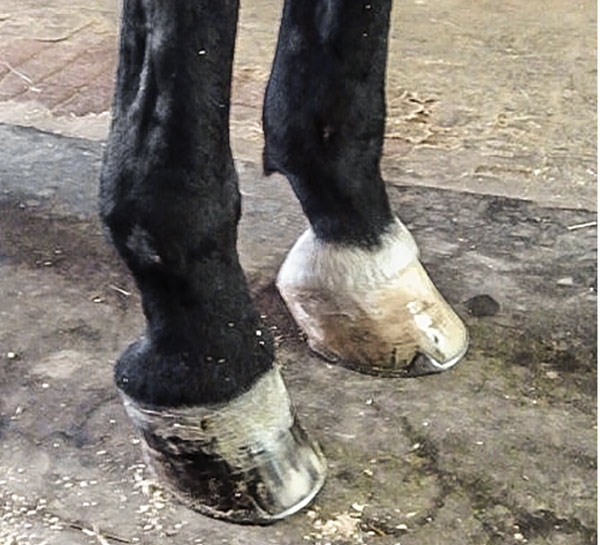
What Advice Has Been Most Helpful When You First Encounter A Club Foot

Ballerina Syndrome Where The Heels Remain Off The Ground Even At The Download Scientific Diagram

How To Manage The Club Foot Birth To Maturity The Horse Club Foot Horses Horse Care

Club Foot Or Upright Foot It S All About The Angles
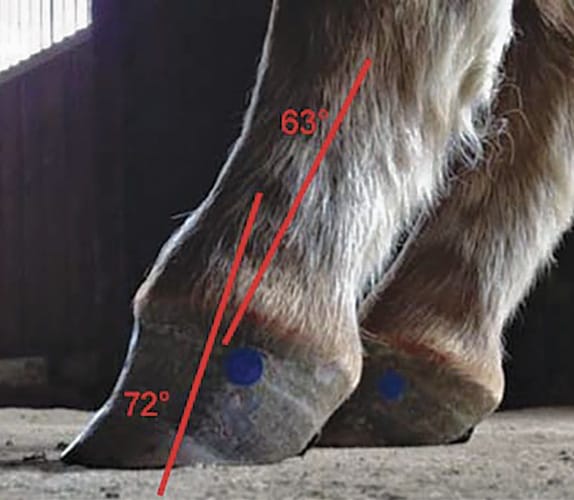
Defining And Fixing A Horse S Club Foot
Club Foot In Horses Equine Chronicle

Why Some Horses Develop A Clubbed Foot Holistichorse Com

How To Treat Club Feet And Closely Related Deep Flexor Contraction

